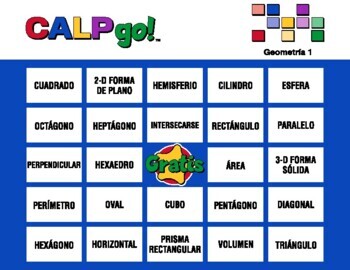Geometry 1 - SPANISH - Academic Language Bingo
CALPgo
5 Followers
Easel Activity Included
This resource includes a ready-to-use interactive activity students can complete on any device. Easel by TPT is free to use! Learn more.
Description
Play bingo in SPANISH and teach your students the vocabulary for 30 essential geometric concepts. Game includes six game boards, thirty calling cards with clear visuals, and worksheets with answer key. A great resource for bilingual or Spanish math centers.
CALPgo! - Cognitive Academic Language Proficiency Bingo - provides students with focused exposure to Tier 2 and Tier 3 vocabulary through engaging bingo games.
Total Pages
Answer Key
N/A
Teaching Duration
N/A
Last updated Dec 2nd, 2020
Report this resource to TPT
Reported resources will be reviewed by our team. Report this resource to let us know if this resource violates TPT’s content guidelines.
Standards
to see state-specific standards (only available in the US).
CCSS1.G.A.2
Compose two-dimensional shapes (rectangles, squares, trapezoids, triangles, half-circles, and quarter-circles) or three-dimensional shapes (cubes, right rectangular prisms, right circular cones, and right circular cylinders) to create a composite shape, and compose new shapes from the composite shape.
CCSS2.G.A.1
Recognize and draw shapes having specified attributes, such as a given number of angles or a given number of equal faces. Identify triangles, quadrilaterals, pentagons, hexagons, and cubes.
CCSS3.G.A.1
Understand that shapes in different categories (e.g., rhombuses, rectangles, and others) may share attributes (e.g., having four sides), and that the shared attributes can define a larger category (e.g., quadrilaterals). Recognize rhombuses, rectangles, and squares as examples of quadrilaterals, and draw examples of quadrilaterals that do not belong to any of these subcategories.
CCSS4.G.A.1
Draw points, lines, line segments, rays, angles (right, acute, obtuse), and perpendicular and parallel lines. Identify these in two-dimensional figures.






